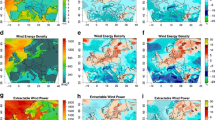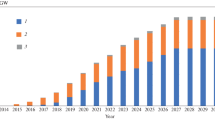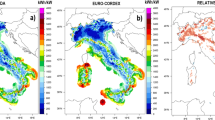Abstract
The climatic effect on the operation of wind power plants in Russia is analyzed. Based on the global experience of wind farms’ operation, a quantitative assessment of the sensitivity of electric power generation by modern wind turbines to wind speed variation is carried out. Using the ensemble approach, predictive estimates of changes in the wind fields in Russia are obtained for the 21st century using the results of general atmospheric circulation models participating in the international project CMIP5 (Coupled Multimodel Intercomparison Project Phase 5). The validity of the findings is ensured by the validation procedure, including a comparison of different versions of the multimodel ensemble with data reanalysis. The predictive estimate obtained for the climatic scenario developed at the National Research University Moscow Power Engineering Institute (NRU MPEI) is compared with generally accepted climatic scenarios based on the use of so-called greenhouse gas representative concentration pathways. It is shown that the choice of the scenario has a significant impact on the forecast results. However, the data of the calculations distinguish several features of the wind regime in the 21st century, which are almost independent of the selected scenario or ensemble composition and, apparently, can be considered reliable. In particular, it is found that there is a possibility of some decrease in average wind speeds across Russia during the 21st century. However, in Primorskiy Kray, the expected climate change will lead to the formation of a zone with a steady increase in its speed. Changes in the technical wind potential in the regions of the country where the construction of wind turbines is planned will amount to from –15 to –20% for the subarctic regions and from +5 to +10% for Primorskiy Kray by the end of the 21st century. It follows from the calculations that the currently observed climate warming, in all likelihood, does not pose a serious threat to the development of wind energy in Russia. The modern and planned location of wind farms even makes it possible to expect some growth in their production rate in the first half of the 21st century. At the same time, the prospect of long-term changes in the wind regime should certainly be taken into account when selecting the wind farm location and predesign analysis as part of the measures aimed at adapting to climate changes.




Similar content being viewed by others
Notes
Reanalysis is the reconstruction of global fields of meteorological quantities by hydrodynamic modeling using observational data.
REFERENCES
M. M. Borisenko, E. O. Gobarova, and E. L. Zhil’tsova, “Assessment of wind energy resources on the territory of Russia,” Tr. Gl. Geofiz. Obs. Im. A. I. Voeikova 557, 53–66 (2008).
G. Ermolenko, I. Gordeev, M. Ryzhenkov, A. Nikomarova, and N. Bogoroditskaya, “Development of grid wind farms in Russia based on the example of a pilot project of the VES Mirny wind farm in the Yeisk district of Krasnodar Kray,” Vetrovaya Energ. 17, 20–30 (2014).
Global and Russian Energy Outlook 2016, Ed. by A. A. Makarov, L. M. Grigor’ev, and T. A. Mitrovaya (Inst. Energ. Issled. Ross. Akad. Nauk — Anal. Tsentr pri Pravitel’stve RF, Moscow, 2016). http://ac.gov.ru/ files/publication/a/10585.pdf
V. V. Elistratov and A. V. Vinogradova (Chernova), “Simulation of WPP/HPP power system operating modes in decentralized power supply system,” Al’tern. Energ. Ekol., No. 9–10, 12–24 (2016). https://doi.org/10.15518/isjaee.2016.09-10.012-024
N. M. Kuznetsov, O. E. Konovalova, and V. V. Pobedonostseva, “Energy efficiency management in the regions of the Arctic zone of the Russian Federation,” Tr. Kol’skogo Nauchn. Tsentra Ross. Akad. Nauk 8 (17), 20–34 (2018).
O. S. Popel’, S. V. Kiseleva, M. O. Morgunova, T. S. Gabderakhmanova, and A. B. Tarasenko, “Use of renewable energy sources for energy supply to consumers in the Arctic zone of the Russian Federation,” Arkt.: Ekol. Ekon. 1 (17), 64–69 (2015).
D. A. Gill, L. A. Ritchie, J. S. Picou, J. Langhinrichsen-Rohling, M. A. Long, and J. W. Shenesey, “The Exxon and BP oil spills: A comparison of psychosocial impacts,” Nat. Hazards 74, 1911–1932 (2014). https://doi.org/10.1007/s11069-014-1280-7
F. Souba and P. B. Mendelson, “Wind Group: Lessons learned beyond wind integration for remote Alaska,” Electr. J. 31 (6), 40–47 (2018). https://doi.org/10.1016/j.tej.2018.06.008
Atlas of Renewable Energy Resources (Ross. Khim.-Tekhnol. Univ Im. D. I. Mendeleeva, Moscow, 2015) [in Russian].
B. V. Ermolenko, G. V. Ermolenko, Y. A. Fetisova, and L. N. Proskuryakova, “Wind and solar PV technical potentials: Measurement methodology and assessments for Russia,” Energy 137, 1001–1012 (2017). https://doi.org/10.1016/j.energy.2017.02.050
E. N. Sosnina, A. V. Shalukho, I. A. Lipuzhin, A. Yu. Kechkin, and A. A. Voroshilov, “Improving the efficiency of decentralized power supply systems,” Tr. NGTU 3 (122), 81–91 (2018).
S. V. Ganaga, Yu. I. Kudryashov, V. G. Nikolaev, V. V. Nikolaev, and E. E. Son, “On the development of the techniques of wind power stations parameters modeling in Russia and CIS countries,” Izv. Ross. Akad. Nauk Energ. 4, 56–76 (2017).
S. Zedda, “Portfolio strategies for renewable energy share maximization,” in Proc. 1st Int. Conf. on Energy Transition in the Mediterranean Area (SyNERGY MED), Cagliari, Italy, May 28–30,2019 (IEEE, Piscataway, NJ, 2019). https://doi.org/10.1109/SyNERGY-MED.2019.8764128
I. Staffell and S. Pfenninger, “Using bias-corrected reanalysis to simulate current and future wind power output,” Energy 114, 1224–1239 (2016). https://doi.org/10.1016/j.energy.2016.08.068
A. Molod, L. Takacs, M. Suarez, and J. Bacmeister, “Development of the GEOS-5 atmospheric general circulation model: Evolution from MERRA to MERRA2,” Geosci. Model Dev. 8, 1339–1356 (2015). https://doi.org/10.5194/gmd-8-1339-2015
https://www.renewables.ninja. Accessed July 25, 2019.
J. Weber, F. Gotzens, and D. Witthaut, “Impact of strong climate change on the statistics of wind power generation in Europe,” Energy Procedia 153, 22–28 (2018). https://doi.org/10.1016/j.egypro.2018.10.004
E. Rusu, “A 30-year projection of the future wind energy resources in the coastal environment of the Black Sea,” Renewable Energy 139, 228–234 (2019). https://doi.org/10.1016/j.renene.2019.02.082
D. Carvalho, A. Rocha, M. Gómez-Gesteira, and C. Silva Santos, “Potential impacts of climate change on European wind energy resource under the CMIP5 future climate projections,” Renewable Energy 101, 29–40 (2017). https://doi.org/10.1016/j.renene.2016.08.036
C. Baumberger, R. Knutti, and G. Hirsch Hadorn, “Building confidence in climate model projections: An analysis of inferences from fit,” Wiley Interdiscip. Rev.: Climate Change 8, e454 (2017). https://doi.org/10.1002/wcc.454
Q. Tian, G. Huang, K. Hu, and D. Niyogi, “Observed and global climate model based changes in wind power potential over the northern hemisphere during 1979–2016,” Energy 167, 1224–1235 (2019). https://doi.org/10.1016/j.energy.2018.11.027
D. van Vuuren, J. Edmonds, M. Kainuma, K. Riahi, A. Thomson, K. Hibbard, G. Hurtt, T. Kram, V. Krey, J. Lamarque, T. Masui, M. Meinshausen, N. Nakicenovic, S. Smith, and S. Rose, “The representative concentration pathways: An overview,” Climatic Change 109, 5–31 (2011). https://doi.org/10.1007/s10584-011-0148-z
C. P. Morice, J. J. Kennedy, N. A. Rayner, and P. D. Jones, “Quantifying uncertainties in global and regional temperature change using an ensemble of observational estimates: The HadCRUT4 data set,” J. Geophys. Res.: Atmos. 117, D08101 (2012). https://doi.org/10.1029/2011JD017187
V. V. Klimenko, A. V. Klimenko, and A. G. Tereshin, “Test of developing long-term forecasts of world energy impact on the Earth’s atmosphere,” Izv. Atmos. Oceanic Phys. 51, 138–147 (2015).
V. A. Govorkova, V. M. Kattsov, V. P. Meleshko, T. V. Pavlova, and I. M. Shkol’nik, “The climate of Russia in the XXI century. Part 2. Assessment of the suitability of the general atmosphere and ocean circulation models CMIP3 for calculating future climate changes in Russia,” Meteorol. Gidrol., No. 8, 47–57 (2008).
A. V. Kislov, V. M. Evstigneev, S. M. Malkhazova, N. N. Sokolikhina, G. V. Surkova, P. A. Toropov, A. V. Chernyshev, and A. N. Chumachenko, Forecast of Climate Resources of the East-European Plain Under Condition of Global Warming in the XXI Century (MAKS, Moscow, 2008) [in Russian].
Evaluation Report on Climate Change and Its Consequences in the Russian Federation, Ed. by V. M. Kattsova and S. M. Semenova, (Rosgidromet, Moscow, 2008) [in Russian].
I. I. Mokhov, A. V. Eliseev, P. F. Demchenko, V. Ch. Khon, M. G. Akperov, M. M. Arzhanov, A. A. Karpenko, V. A. Tikhonov, A. V. Chernokul’skii, and E. V. Sigaeva, “Climate changes and their assessment based on the IAP RAS global model simulations,” Dokl. Earth Sci. 402, 591–595 (2005).
V. P. Meleshko and V. A. Govorkova, “Performance of CMIP3 and CMIP5 models in simulation of current climate,” Tr. Gl. Geofiz. Obs. im. A. I. Voeikova, No. 568, 26–50 (2013).
I. M. Shkol’nik, V. P. Meleshko, V. V. Stadnik, E. I. Khlebnikova, E. M. Akent’eva, E. L. Genikhovich, and A. A. Kiselev, “Impact of climate change on energy production and consumption in Russia,” Tr. Gl. Geofiz. Obs. im. A. I. Voeikova, No. 573, 92–222 (2014).
G. V. Surkova and A. A. Krylov, “Changes in the average and extreme wind speeds in the Arctic during the late XXI century,” Arkt. Antarkt. 3, 26–36 (2018).
D. Bi, M. Dix, S. Marsland, S. O’Farrell, H. Rashid, P. Uotila, A. Hirst, E. Kowalczyk, M. Golebiewski, A. Sullivan, H. Yan, N. Hannah, C. Franklin, Z. Sun, P. Vohralik, I. Watterson, X. Zhou, R. Fiedler, M. Collier, Y. Ma, J. Noonan, L. Stevens, P. Uhe, H. Zhu, S. Griffies, R. Hill, C. Harris, and K. Puri, “The ACCE-SS coupled model: Description, control climate and evaluation,” Aust. Meteorol. Mag. Oceanogr. J. 63, 41–64 (2013). https://doi.org/10.22499/2.6301.004
D. Ji, L. Wang, J. Feng, Q. Wu, H. Cheng, Q. Zhang, J. Yang, W. Dong, Y. Dai, D. Gong, R.-H. Zhang, X. Wang, J. Liu, J. C. Moore, D. Chen, and M. Zhou, “Description and basic evaluation of Beijing Normal University Earth System Model (BNU-ESM) version 1,” Geosci. Model Dev. 7, 2039–2064 (2014). https://doi.org/10.5194/gmd-7-2039-2014
V. K. Arora and G. J. Boer, “Terrestrial ecosystems response to future changes in climate and atmospheric CO2 concentration,” Biogeosciences 11, 4157–4171 (2014). https://doi.org/10.5194/bg-11-4157-2014
P. G. Fogli and D. Iovino, CMCC-CCESM: Toward the New CMCC Earth System Model, CMCC Research Paper No. 248 (SSRN, 2015). https://doi.org/10.2139/ssrn.2603176
A. Voldoire, E. Sanchez-Gomez, D. Salas y Mélia, B. Decharme, C. Cassou, S. Sénési, S. Valcke, I. Beau, A. Alias, M. Chevallier, M. Déqué, J. Deshayes, H. Douville, E. Fernandez, G. Madec, E. Maisonnave, M. P. Moine, S. Planton, D. Saint-Martin, S. Szopa, S. Tyteca, R. Alkama, S. Belamari, A. Braun, L. Coquart, and F. Chauvin, “The CNRM-CM5.1 global climate model: Description and basic evaluation,” Climate Dyn. 40, 2091–2121 (2013). https://doi.org/10.1007/s00382-011-1259-y
H. B. Gordon, S. P. O’Farrell, M. A. Collier, M. R. Dix, L. D. Rotstayn, E. A. Kowalczyk, A. C. Hirst, and I. G. Watterson, The CSIRO Mk3.5 Climate Model, CAWCR Technical Report No. 021. (CSIRO Mar. and Atmos. Res., 2010).
S. M. Griffies, M. Winton, L. J. Donner, L. W. Horowitz, S. M. Downes, R. Farneti, A. Gnanadesikan, W. J. Hurlin, H. C. Lee, Z. Liang, J. B. Palter, B. L. Samuels, A. T. Wittenberg, B. L. Wyman, J. Yin, and N. Zadeh, “The GFDL CM3 coupled climate model: Characteristics of the ocean and sea ice simulations,” J. Clim. 24, 3520–3544 (2011). https://doi.org/10.1175/2011JCLI3964.1
J. P. Dunne, J. G. John, S. Shevliakova, R. J. Stouffer, J. P. Krasting, S. L. Malyshev, P. C. Milly, L. T. Sentman, A. J. Adcroft, W. Cooke, K. A. Dunne, S. M. Griffies, R. W. Hallberg, M. J. Harrison, H. Levy, A. T. Wittenberg, P. J. Phillips, and N. Zadeh, “GFDL’s ESM2 global coupled climate-carbon earth system models. Part II: Carbon system formulation and baseline simulation characteristics,” J. Clim. 26, 2247–2267 (2013). https://doi.org/10.1175/JCLI-D-12-00150.s1
G. M. Martin, N. Bellouin, W. J. Collins, I. D. Culverwell, P. R. Halloran, S. C. Hardiman, T. J. Hinton, C. D. Jones, R. E. McDonald, A. J. McLaren, F. M. O’Connor, M. J. Roberts, J. M. Rodriguez, S. Woodward, M. J. Best, M. E. Brooks, A. R. Brown, N. Butchart, C. Dearden, S. H. Derbyshire, I. Dharssi, M. Doutriaux-Boucher, J. M. Edwards, P. D. Falloon, N. Gedney, L. J. Gray, H. T. Hewitt, M. Hobson, M. R. Huddleston, J. Hughes, S. Ineson, W. J. Ingram, P. M. James, T. C. Johns, C. E. Johnson, A. Jones, C. P. Jones, M. M. Joshi, A. B. Keen, S. Liddicoat, A. P. Lock, A. V. Maidens, J. C. Manners, S. F. Milton, J. G. Rae, J. K. Ridley, A. Sellar, C. A. Senior, I. J. Totterdell, A. Verhoef, P. L. Vidale, and A. Wiltshire, “The HadGEM2 family of Met Office Unified Model climate configurations,” Geosci. Model Dev. 4, 723–757 (2011). https://doi.org/10.5194/gmd-4-723-2011
J. L. Dufresne, M. A. Foujols, S. Denvil, A. Caubel, O. Marti, O. Aumont, Y. Balkanski, S. Bekki, H. Bellenger, R. Benshila, S. Bony, L. Bopp, P. Braconnot, P. Brockmann, P. Cadule, F. Cheruy, F. Codron, A. Cozic, D. Cugnet, N. de Noblet, J. P. Duvel, C. Ethé, L. Fairhead, T. Fichefet, S. Flavoni, P. Friedlingstein, J. Y. Grandpeix, L. Guez, E. Guilyardi, D. Hauglustaine, F. Hourdin, A. Idelkadi, J. Ghattas, S. Joussaume, M. Kageyama, G. Krinner, S. Labetoulle, A. Lahellec, M. P. Lefebvre, F. Lefevre, C. Levy, Z. X. Li, J. Lloyd, F. Lott, G. Madec, M. Mancip, M. Marchand, S. Masson, Y. Meurdesoif, J. Mignot, I. Musat, S. Parouty, J. Polcher, C. Rio, M. Schulz, D. Swingedouw, S. Szopa, C. Talandier, P. Terray, N. Viovy, and N. Vuichard, “Climate change projections using the IPSL-CM5 Earth System Model: From CMIP3 to CMIP5,” Clim. Dyn. 40, 2123–2165 (2013). https://doi.org/10.1007/s00382-012-1636-1
M. Watanabe, T. Suzuki, R. O’Ishi, Y. Komuro, S. Watanabe, S. Emori, T. Takemura, M. Chikira, T. Ogura, M. Sekiguchi, K. Takata, D. Yamazaki, T. Yokohata, T. Nozawa, H. Hasumi, H. Tatebe, and M. Kimoto, “Improved climate simulation by MIROC5: Mean states, variability, and climate sensitivity,” J. Clim. 23, 6312–6335 (2010). https://doi.org/10.1175/2010JCLI3679.1
S. Watanabe, T. Hajima, K. Sudo, T. Nagashima, T. Takemura, H. Okajima, T. Nozawa, H. Kawase, M. Abe, T. Yokohata, T. Ise, H. Sato, E. Kato, K. Takata, S. Emori, and M. Kawamiya, “MIROC-ESM 2010: Model description and basic results of CMIP5-20c3m experiments,” Geosci. Model Dev. 4, 845–872 (2011). https://doi.org/10.5194/gmd-4-845-2011
M. A. Giorgetta, J. Jungclaus, C. H. Reick, S. Legutke, J. Bader, M. Böttinger, V. Brovkin, T. Crueger, M. Esch, K. Fieg, K. Glushak, V. Gayler, H. Haak, H. Hollweg, T. Ilyina, S. Kinne, L. Kornblueh, D. Matei, T. Mauritsen, U. Mikolajewicz, W. Mueller, D. Notz, F. Pithan, T. Raddatz, S. Rast, R. Redler, E. Roeckner, H. Schmidt, R. Schnur, J. Segschneider, K. D. Six, M. Stockhause, C. Timmreck, J. Wegner, H. Widmann, K. Wieners, M. Claussen, J. Marotzke, and B. Stevens, “Climate and carbon cycle changes from 1850 to 2100 in MPI-ESM simulations for the Coupled Model Intercomparison Project phase 5,” J. Adv. Modeling Earth Syst. 5, 572–597 (2013). https://doi.org/10.1002/jame.20038
S. Yukimoto, Y. Adachi, M. Hosaka, T. Sakami, H. Yoshimura, M. Hirabara, T. Y. Tanaka, E. Shindo, H. Tsujino, M. Deushi, R. Mizuta, S. Yabu, A. Obata, H. Nakano, T. Koshiro, T. Ose, and A. Kitoh, “A new global climate model of the Meteorological Research Institute: MRI–CGCM3-model description and basic performance,” J. Meteorol. Soc. Jpn. 90A, 23–64 (2012). https://doi.org/10.2151/jmsj.2012-A02
X. Xiao Ge, W. Tong Wen, and Z. Jie, “Introduction of CMIP5 experiments carried out with the Climate System Models of Beijing Climate Center,” Adv. Clim. Change Res. 4, 41–49 (2013). https://doi.org/10.3724/sp.j.1248.2013.041
E. M. Volodin, N. A. Dianskii, and A. V. Gusev, “Simulating present-day climate with the INMCM4.4 coupled model of the atmospheric and oceanic general circulations,” Izv. Atmos. Oceanic Phys. 46, 414–431 (2010).
V. V. Klimenko and E. V. Fedotova, “Development of multi-model ensemble climate estimates using open-source environment,” IOP Conf. Ser.: Earth Environ. Sci. 211, 012084 (2018). https://doi.org/10.1088/1755-1315/211/1/012084
G. P. Compo, J. S. Whitaker, P. D. Sardeshmukh, N. Matsui, R. J. Allan, X. Yin, B. E. Gleason, R. S. Vose, G. Rutledge, P. Bessemoulin, S. Bronnimann, M. Brunet, R. I. Crouthamel, A. N. Grant, P. Y. Groisman, P. D. Jones, M. C. Kruk, A. C. Kruger, G. J. Marshall, M. Maugeri, H. Y. Mok, Ø. Nordli, T. F. Ross, R. M. Trigo, X. L. Wang, S. D. Woodruff, and S. J. Worley, “The Twentieth Century Reanalysis Project,” Q. J. R. Meteorol. Soc. 137, 1–28 (2011). https://doi.org/arXiv 1011.1669v3
O. N. Bulygina, N. N. Korshunova, and V. N. Razuvaev, “Changes in the wind regime over Russia in the last decades,” Tr. Gl. Geofiz. Obs. im. A. I. Voeikova, 568, 156–172 (2013).
Second Assessment Report on Climate Change and its Consequences in the Russian Federation, Ed. by V. M. Kattsov and S. M. Semenov (Rosgidromet, Moscow, 2014) [in Russian].
V. Klimenko, A. Tereshin, and O. Mikushina, “Increase of energy potential of Russian forest resources due to climate change and CO2 fertilization,” E3S Web Conf. 103, 02005 (2019). https://doi.org/10.1051/e3sconf/201910302005
I. Tobin, W. Greuell, S. Jerez, F. Ludwig, R. Vautard, M. T. H. van Vliet, and F.-M. Breon, “Vulnerabilities and resilience of European power generation to 1.5°C, 2°C and 3°C warming,” Environ. Res. Lett. 13, 044024 (2018). https://doi.org/10.1088/1748-9326/aab211
ACKNOWLEDGMENTS
We are grateful to the German Climate Computing Center and the CMIP5 teams listed in Table 2 for the granted assess to the project results. The authors also highly appreciate efforts of the Renewables.ninja developers Dr. S. Pfenninger and Dr. I. Staffell on sharing their research results in an open and transparent way.
Funding
This work was supported by the Russian Science Foundation (project no. 18-79-10255).
Author information
Authors and Affiliations
Corresponding author
Additional information
Translated by A. Kolemesin
Rights and permissions
About this article
Cite this article
Klimenko, V.V., Fedotova, E.V. Long-Term Development Prospects of Russia’s Wind Energy in the Conditions of Expected Climate Changes. Therm. Eng. 67, 331–342 (2020). https://doi.org/10.1134/S0040601520060051
Received:
Revised:
Accepted:
Published:
Issue Date:
DOI: https://doi.org/10.1134/S0040601520060051




